Over 12 percent of adults in the United States have a specific phobia, says the National Institute of Mental Health (NIMH). One common phobia is the fear of birds, called ornithophobia. It’s important to understand what scares birds to make their environment safer and more comfortable.
Birds, being prey animals, are naturally cautious and alert. They show fear in many ways, from wild birds to pets. By looking into what scares birds, we can make their lives better and less stressful.
Key Takeaways
- Birds are scared of many things, like loud noises, other pets, and strangers.
- Knowing what scares birds helps owners keep them happy and healthy.
- Phobias like ornithophobia are common and can be treated.
- Creating a safe and interesting environment helps birds feel better.
- Introducing new things slowly and keeping routines can help birds feel less scared.
Understanding Bird Fear Responses
Birds have amazing survival instincts from millions of years of evolution. These instincts help them quickly react to threats. The amygdala, a brain part, plays a key role in processing emotions, just like in humans.
When birds see danger, their amygdala kicks in. This starts a series of changes to help them survive.
Natural Instincts and Survival Mechanisms
Birds’ fear responses come from their dinosaur ancestors. They have instincts to detect threats, avoid danger, and warn others. Birds’ fear responses show their amazing adaptation and resilience over millions of years.
How Birds Process Fear
The amygdala is key in how birds feel fear. When a bird sees danger, its amygdala makes it ready to act. This includes a faster heart rate, quick breathing, and stress hormones.
This state gets the bird ready to run away or face the danger.
Physical Signs of Fear in Birds
- Fluffed-up feathers, as the bird tries to look bigger and scarier
- Rapid, shallow breathing, showing it’s very alert
- Wide, alert eyes, looking for threats
- Trying to flee or hide in a safe spot
- Vocalizations, like squawking or screaming, to signal distress or alarm
These signs of fear in birds help us understand their emotions. It’s important for their care in both captivity and the wild.
What Are Birds Scared Of? Natural Predator Fears
Birds, both wild and domestic, fear many predators. These include eagles, hawks, and crows. These birds can make our feathered friends very scared.
Just seeing a shadow fly by can scare a pet bird. They know it might be a predator. This fear is a survival tool they’ve developed over time.
The Audubon Society says 2.9 billion breeding adult birds have disappeared in the U.S. in 50 years. Climate change and bird deterrents are big reasons. Knowing what scares birds helps keep them safe.
“Predator-induced fear in wild animals can have long-lasting consequences, thereby transforming subsequent reactions to predators.”
Predator fear deeply affects birds. It makes them more alert, eat less, and even suffer from PTSD-like symptoms. By understanding these fears, we can help keep birds safe. This also makes their environment calmer and more secure.
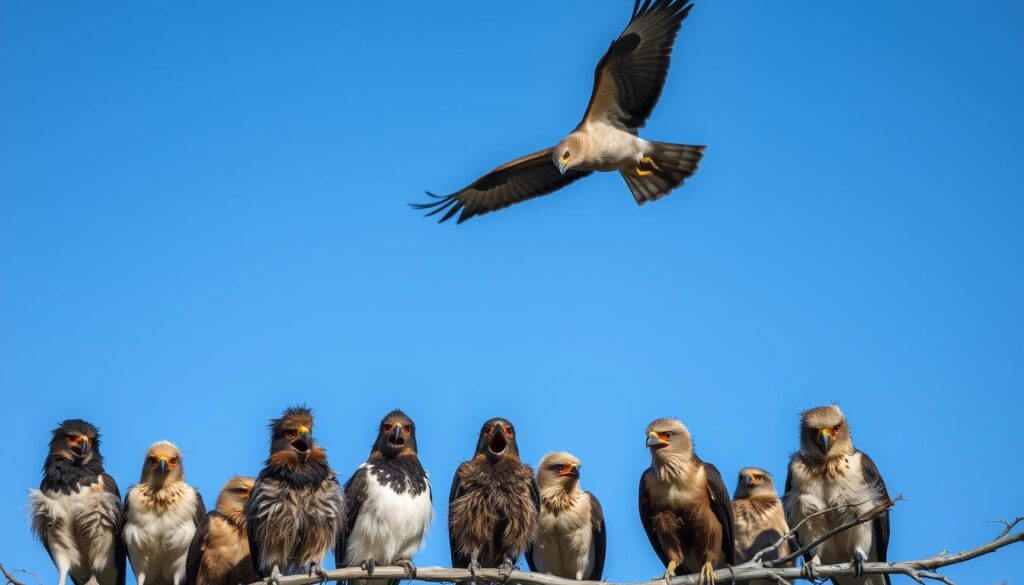
| Bird Predator | Impact on Birds |
|---|---|
| Eagles and Hawks | Trigger intense fear responses in both wild and pet birds |
| Crows | Their calls can alarm and frighten birds |
| Flying Shadows | Can cause panic in indoor pet birds, who recognize the silhouette of a predator |
The Impact of Loud Noises on Bird Behavior
Loud noises can really upset birds, causing them stress and disrupting their natural habits. Sounds like construction, slamming doors, or sirens can scare them. In cities, where noise is always there, birds face even more danger.
Sudden Sounds and Startling Effects
Research shows loud, sudden noises can make birds very scared. For instance, a study on zebra finches found they got quieter and more still when they heard a fire alarm. This scared behavior lasted for over 15 minutes after the alarm stopped.
Urban Noise Impacts on Birds
The constant noise in cities is bad for birds. The American Bird Conservancy says millions of birds crash into buildings every year, partly because of noise. This noise messes with birds’ ways of talking and finding mates, leading to fewer birds.
Managing Noise-Related Stress in Birds
To lessen the noise stress on birds, we need quiet areas and to get them used to sounds slowly. Using ultrasonic devices can help keep bird numbers down without hurting them. By learning about bird noise issues, we can protect their homes and keep them healthy.
“Sudden loud noises can disrupt birds’ daily routines and behaviors, leading to stress and potential negative impacts on their health and well-being.”
Understanding how loud noises affect birds is key to fixing noise problems. This knowledge helps us find ways to live better with birds in our world.
Wild Birds as a Source of Fear for Pet Birds
Many pet birds live in fear of wild birds, even when they’re indoors. The sight or sound of wild birds can make them call out for help, stand up to defend themselves, or try to hide. This fear comes from knowing who their natural enemies are, even if they’ve never met them before.
When wild birds are near, pet birds get very anxious and stressed. They might flap their wings a lot, stay hidden, or even hurt themselves. This fear is a leftover from their ancestors’ need to survive.
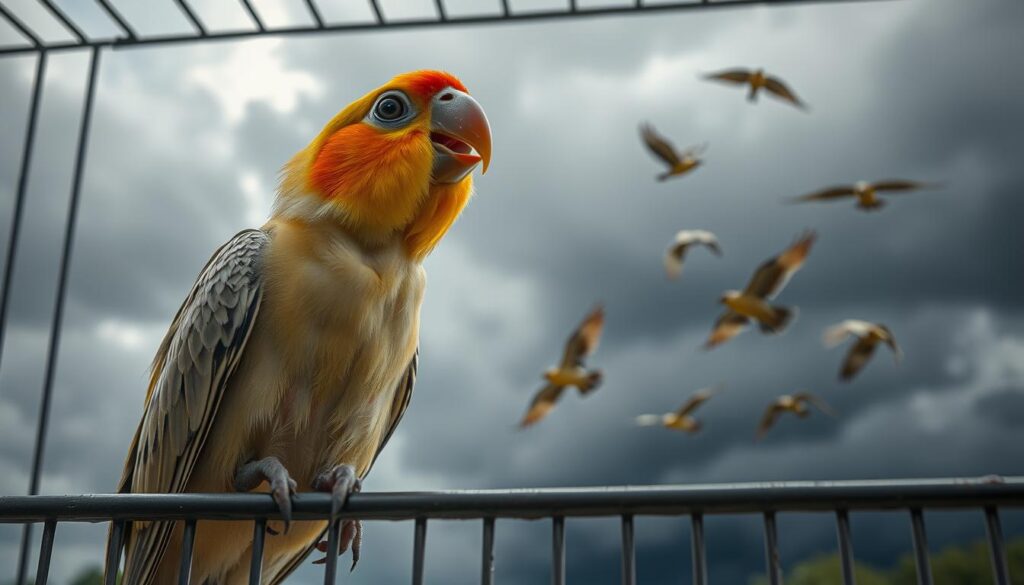
But it’s not just outdoor birds that are scared. Indoor birds can also get upset by birds outside or their calls. This is especially true for birds with big windows or homes near where wild birds live.
To make their birds feel better, owners can try a few things. They can put up screens, close curtains, or use things to keep wild birds away. They can also give their birds places to hide, perches, and things to do to make them feel safe and happy.
Understanding why birds are scared and taking steps to help them can make a big difference. It can make their lives better and happier.
Fear of Other Household Pets and Animals
Many bird owners worry about their pets being scared of other pets at home. Cats and dogs might not even notice the birds, but seeing them can still scare the birds a lot. It’s important to keep birds and other pets in separate places and watch them when they’re together.
Cat and Dog Interactions
Birds often see cats and dogs as threats, even if they mean no harm. This fear can make birds very loud or even fight back. Always watch birds and other pets together to avoid any harm.
Some birds might never get used to living with other animals. In these cases, keeping them separate is the best way to keep them safe and happy.
Creating Safe Spaces for Birds
Having a special place for birds can help them feel less scared. This could be a room just for their cage or a spot where they can hide. Adding toys and places to hide can make them feel safer and more comfortable.
By giving birds a safe place, owners can help them feel less stressed. This can make their lives better and reduce their fear and anxiety.
“Ornithophobia, the fear of birds, is more common than you might think. Even celebrities like Lucille Ball have struggled with this specific phobia.”
Dark Environments and Night Fears
Many birds fear darkness just like humans do. Night frights make them flap wildly in their cages when it gets dark. Cockatiels are especially scared, showing the worst cases of night frights among parrots.
This fear comes from their instinct to flee when startled. In the wild, birds fly away when they sense danger. But in cages, this instinct turns into frantic thrashing. A night light can help, as seen with Magoo, who felt safer in a dimly lit space.
Experts say not to cover birds at night if they’re scared. Instead, give them 10 hours of sleep to avoid stress. Soft music or rainforest sounds can also calm them down.
If a bird has a night fright, turn on the light and speak softly. Stay with it until it calms down. Over time, some birds may learn to sleep in the dark or prefer a dimly lit room.
Conquering Night Frights in Cockatiels
Cockatiels are very prone to night frights. Owners often see these episodes, showing how common it is. Causes include other pets, bugs, moving shadows, car headlights, drafts, and sudden noises.
To help cockatiels, change their nighttime space. Use a smaller cage in a quiet room and install heavy blinds. Dim lighting also helps. After a fright, they may pace, hiss, breathe heavily, and get agitated. Calming them down by turning on the light and speaking softly is key.
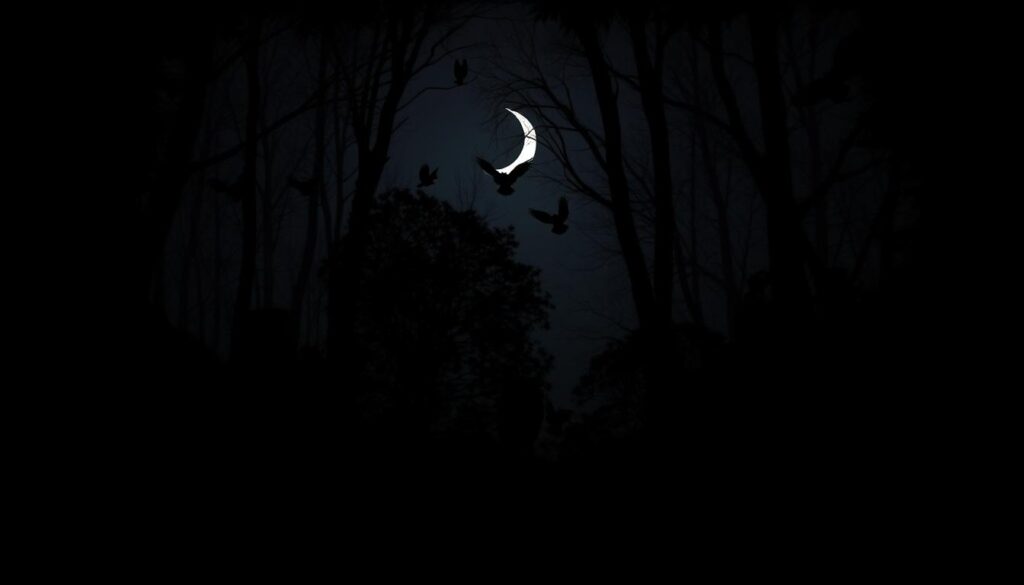
“Providing light to calm birds during night fright episodes is crucial for helping them settle back to sleep.”
– Patty Jourgensen, Avian Specialist
Understanding bird phobias and using the right solutions can make nights safer for birds. This way, owners can reduce the scary things that scare birds.
Strange Objects and New Toys
Birds often get scared of strange objects and new toys. They see unfamiliar things as threats, which makes them afraid. Bird aversion to new items is common. Birds might fear colors, textures, or even things like chairs or sunglasses.
This fear can show in different ways. Birds might destroy their feathers, preen too much, or hurt themselves. For example, a Goffin’s cockatoo was very scared of toys. It took time and a slow introduction to help the bird enjoy the toys.
Adaptation Period for New Items
When introducing new things to a bird’s space, be careful and patient. Experts say to let birds get used to new objects slowly. This helps them see the new item as interesting, not scary.
Safe Introduction Methods
- Start by placing new objects near the bird’s cage for them to see.
- Encourage the bird to play with the new item by giving treats or praise.
- Don’t rush the process. It can stress the bird out.
By following these steps and giving birds time, owners can help them feel safe. This way, birds can learn to trust their environment more.
https://www.youtube.com/watch?v=K19kedVp4ps
“Familiarity with the toy led to a positive shift in the bird’s perception, from fear of the unknown to viewing the object as a source of enjoyment.”
Having a specialist like Patty Jourgensen is very helpful. She knows a lot about birds and how to deal with their fears. With patience and the right plan, owners can help their birds get over their fears of new things.
| Behavioral Responses to Fear | Percentage of Birds Exhibiting |
|---|---|
| Holding out wings | 87.5% |
| Weight shifting back and forth | 65% |
| Stretching out neck | 42.5% |
| Shrieking | 23% |
| Pacing or climbing laps | 15% |
| Nail biting | 6% |
Understanding bird aversion behaviors and using safe introduction methods helps. This way, owners can make a safe and enriching space for their birds to thrive.
Human Interactions and Stranger Danger
Birds can form strong bonds with their owners. But, they can be scared of strangers. They might make loud noises or seek comfort from their owners when they see someone new.
Urban birds, like pigeons, get used to city life and see humans as a food source. Rural birds, on the other hand, are more cautious around humans. They get used to humans over time through gentle interactions.
When birds have positive experiences with humans, they learn to trust them. It’s important to understand their body language and sounds. They might fly away or act aggressively when they feel threatened.
“The quality of human-animal interactions can impact productivity and welfare with regular pleasant contact resulting in desirable alterations in physiology, behavior, health, and productivity of farm animals.”
We can make our birds feel safe by creating a welcoming space. Being patient and gentle helps them feel secure. Slowly introducing them to new situations also helps.
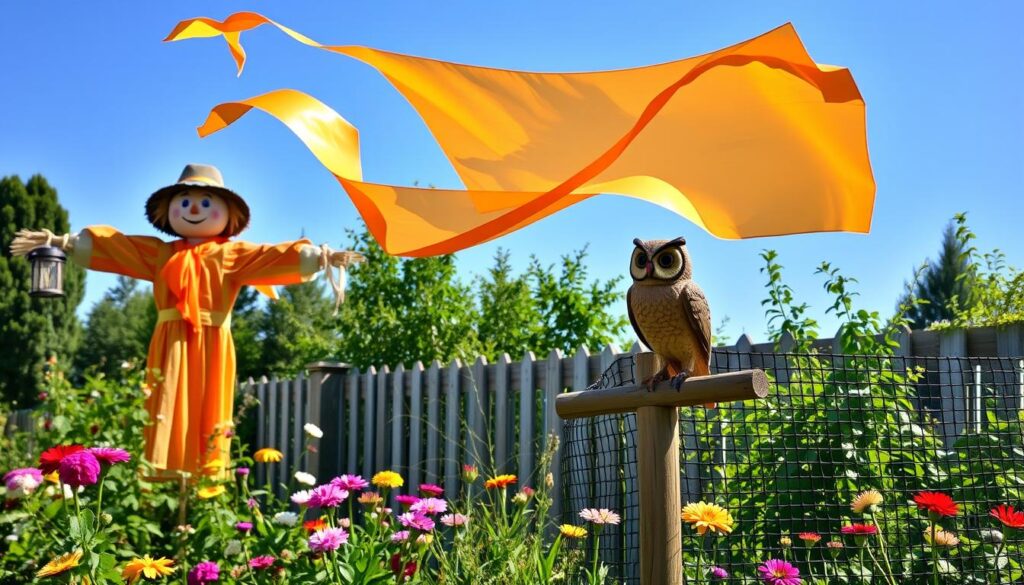
Environmental Changes and Weather-Related Fears
Birds are very sensitive to changes in their environment, especially weather. Storms with thunder and lightning can really scare them. Also, changes in daylight and temperature affect their behavior and stress levels.
Storm Reactions
Thunder and lightning can startle birds. They might show fear by trembling, hiding, or trying to escape. A quiet, safe space during storms can help reduce their anxiety.
Seasonal Changes Impact
Seasonal changes mean birds have to adjust to new daylight and temperatures. These changes can disrupt their sleep, eating, and overall health. Keeping a consistent routine and environment is key to reducing stress and keeping them happy.
Understanding how weather and environmental changes affect birds helps us prepare better. By providing hiding spots and reducing loud noises during storms, we can scare away birds and lessen their fear and anxiety.
Common Household Items That Frighten Birds
As pet bird owners know, everyday items can scare our feathered friends. Things like balloons, umbrellas, vacuum cleaners, and certain clothes can frighten birds. Knowing what bird scarers are can help make their home more comfortable.
Balloons are a big surprise for birds. Their shape, movement, and sound are unsettling. Umbrellas also scare birds because they change suddenly from small to big and loud.
- Vacuum cleaners are another item that frightens birds. The loud noise and vibrations are seen as threats, making birds upset and distressed.
- Certain clothes, like hats or sunglasses, can also scare birds. The strange shape and movement of these items look like predators, making birds feel scared and unsafe.
Knowing about these bird scarers helps bird owners make their homes safer. With patience and understanding, birds can get over their fears and feel safe at home.
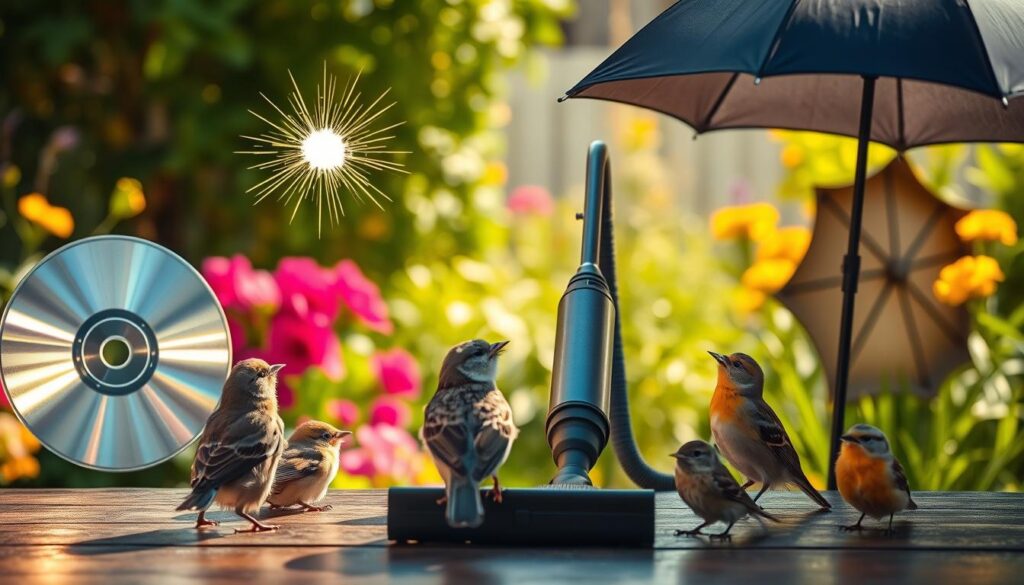
“The key to addressing bird fears is to understand their natural instincts and create a safe, comfortable environment that minimizes potential sources of distress.”
Understanding Bird Phobias and Anxiety
Birds can have phobias and anxiety just like humans. The fear of birds, called ornithophobia, affects many people globally. This fear can come from bad experiences or just not liking birds.
Signs of Bird Stress
It’s important to know when birds are stressed. This helps us find and fix anxiety problems. Some signs of bird stress include:
- Excessive vocalization
- Feather plucking
- Aggression
- Withdrawal or hiding behavior
Behavioral Changes
Changes in a bird’s behavior can show bird aversion or anxiety. Birds might avoid places or activities because of birds. Spotting these changes early is key to helping them.
| Statistic | Value |
|---|---|
| Ornithophobia Prevalence | Up to 5% of the general population |
| Feral Pigeons in the UK | More than 18 million in every city and town |
| Diseases Transmitted by Birds | Up to 60 different diseases, including respiratory illnesses, yeast infections, and avian influenza |
Getting help from a mental health expert is vital for beating bird phobias. They can use therapy, exposure, and sometimes medicine. These methods help people face and conquer their fear of birds.
How to Help Birds Overcome Their Fears
Helping birds overcome their fears needs patience and positive reinforcement. Birds are very sensitive and their fears are part of their survival instincts. By understanding what scares them and using gentle exposure, we can help them feel more confident.
Desensitization is a great way to tackle bird fears. It means slowly getting them used to what scares them, starting from far away. As they get closer, give them treats and comfort. This way, they learn to see the scary thing as something good.
For really bad fears, you might need a bird behaviorist. They can make a special plan to help the bird. They might suggest special training, changing the bird’s environment, or even medicine.
It’s also important to make a safe and predictable home for the bird. A routine and a cozy space can make them feel secure. This helps them feel less scared of their surroundings.
Every bird is different, and their fears can vary. But with kindness, patience, and a focus on their happiness, we can help them feel better. This way, they can live happier lives.
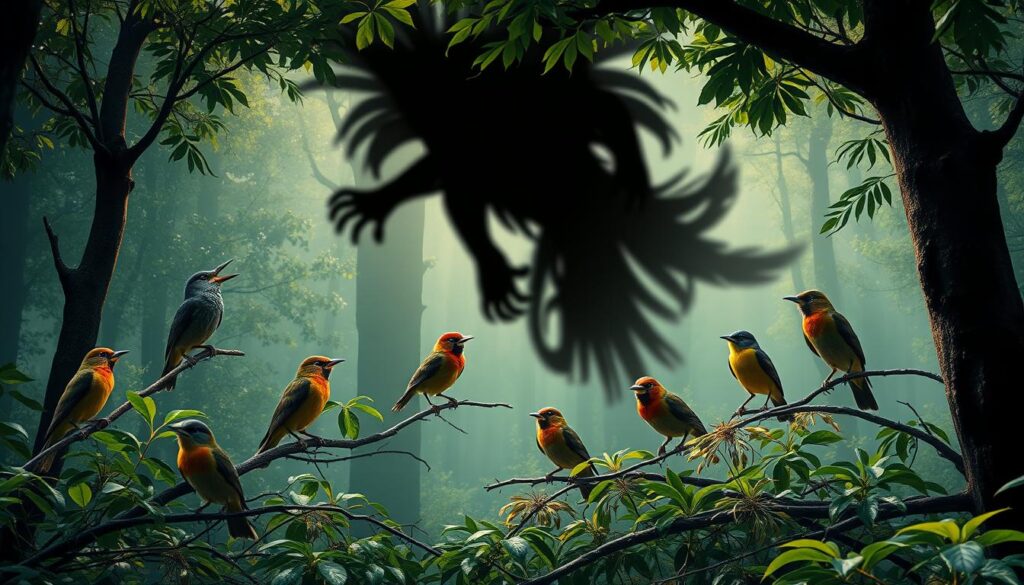
| Behavioral Indicators of Bird Fears | Relaxed Behavior Traits |
|---|---|
|
|
Creating a Safe Environment for Birds
Creating a safe and caring space is key for our feathered friends. Bird care focuses on cage placement and adding fun things to their area. This helps reduce stress and fear.
Cage Placement Tips
Putting the cage in the right spot is vital for a bird’s safety. Stay away from drafts, loud noises, and busy places. Choose a quiet, bright spot, away from windows and doors.
Make sure the cage is big enough. This lets birds move and exercise freely.
Environmental Enrichment
Adding the right toys, perches, and fun activities is great for your bird. Use different size perches to encourage climbing. Add foraging toys to keep their minds sharp.
Keep the cage and toys clean. This keeps your bird’s home healthy and stress-free.
By making a safe and fun home, your bird will do well. A happy bird is a joy to watch!
“The best way to help a bird overcome its fears is to provide a safe, comfortable, and enriched environment where it can feel secure and confident.”
Natural vs. Learned Fear Responses
Birds have different types of fear responses. These can be natural or learned. Natural fears, like avoiding snakes and spiders, come from their evolutionary past. These instincts are shared with many animals, including humans, and help them survive.
Learned fears, however, come from negative experiences or watching others. Studies with rhesus monkeys show they can learn to fear snakes and crocodiles without direct contact. This shows they naturally fear real dangers more than new things.
Knowing the difference between natural and learned fears in birds helps us better understand and change their fears. This is especially important for birds kept in captivity or as pets. By understanding their fears, we can create a safer and more enriching space for them. This helps improve their well-being and reduces bird aversion to different things.
FAQ
What are the common fears and phobias experienced by birds?
Birds, being prey animals, fear many things. This includes wild birds, loud noises, and other pets. They also fear new objects, strangers, dark places, and sudden changes. Knowing these fears helps bird owners and those interested in bird behavior.
How do birds process and respond to fear?
Birds have survival instincts that make them fearful. They process fear like humans do, through their amygdala. Signs of fear include fluffed feathers, rapid breathing, and wide eyes. They may try to flee or hide and vocalize their distress.
What are some of the natural predator fears that birds experience?
Birds naturally fear predators like eagles and hawks. They also fear crows and their calls. Even indoor birds can be startled by shadows of flying predators.
How do loud noises impact bird behavior and how can it be managed?
Loud noises can startle birds, causing them to scream, fly erratically, or seek shelter. To manage this, create quiet zones and gradually introduce common sounds.
Why do pet birds often fear wild birds, even when indoors?
The sight or sound of wild birds can alarm pet birds. This fear comes from instinctual predator recognition, even without direct encounters.
How do household pets like cats and dogs affect bird behavior?
Pets like cats and dogs can frighten birds, even if they show no interest. It’s important to create safe spaces and supervise interactions. Some birds may never get used to other pets.
Why are birds often afraid of darkness and how can this fear be addressed?
Birds fear darkness, causing night frights. They may flap around their cages in panic. Night lights and light-colored cage covers can help. Gradual exposure to dark can also help some birds adapt.
Why do birds often fear new objects in their environment, and how can they be introduced safely?
Birds fear new objects, including toys. They need time to adapt when new items are introduced. Safe introduction involves placing new objects near but not in the cage. Positive reinforcement when they show interest is also helpful.
Why are strangers a source of fear for many birds?
Strangers can frighten birds, even if they bond with their owners. Birds may react negatively to unfamiliar people, especially those who approach quickly. They may vocalize their discomfort or seek reassurance from their owners.
How can environmental changes, particularly weather-related events, affect bird behavior and stress levels?
Changes like storms or seasonal changes can frighten birds. Keeping their environment stable and secure is key to their well-being during these times.
What are some unexpected household items that can trigger fear responses in birds?
Items like balloons, umbrellas, and vacuum cleaners can frighten birds. Being aware of these items can help create a more comfortable environment for them.
How can bird owners recognize and address potential phobias and anxiety disorders in their birds?
Birds can develop phobias and anxiety disorders like humans. Signs include excessive vocalization, feather plucking, aggression, or withdrawal. Recognizing these signs early can lead to effective management and treatment, possibly with professional help.
What are some effective methods for helping birds overcome their fears?
Helping birds overcome fears requires patience and positive reinforcement. Gradual exposure to feared stimuli, with rewards and comfort, can help. Creating a supportive, predictable environment is crucial for building confidence.
What elements are important for creating a safe environment for birds?
A safe environment for birds includes proper cage placement and environmental enrichment. This includes toys, perches, and interactive elements. Regular routines and a balanced diet also contribute to their well-being and resilience against fears.
How do natural and learned fear responses differ in birds, and how can this understanding help address bird fears?
Birds have both natural and learned fears. Natural fears, like predator avoidance, are instinctual. Learned fears develop through negative experiences or observations. Understanding this difference can help in addressing and modifying fear responses in birds, especially in captive or pet bird situations.

